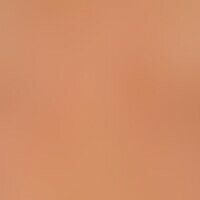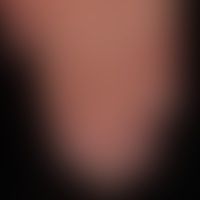Image diagnoses for "Macule"
325 results with 1215 images
Results forMacule

Vitiligo (overview) L80
Vitiligo (differential diagnosis): Halo-like depigmentation of the skin in metastasized melanoma; Balau-translucent the deep cutaneous melanoma metastases.

Artifacts L98.1

Solar dermatitis L55.-
Dermatitis solaris: Large, very painful erythema with beginning blister formation on the back of the foot. 30-year-old patient after several hours of sunbathing in the midday sun.

Varicella B01.9
Varicella: generalized exanthema with juxtaposition of vesicles, papules, papulopustules, here infestation of the palms with vesicles, papules and pustules.

Phototoxic dermatitis L56.0

Amiodarone hyperpigmentation T78.9
Amiodarone hyperpigmentation: grey-blue hyperpigmentation after long-term application of the preparation due to tachyarrhythmia, partly splashlike, partly flat grey-blue discolouration.

Poikiloderma (overview) L81.89
Poikiloderma: chronic graft versus host disease with bunchy, hyper- and depigmented indurated plaques. detailed picture.

Phototoxic dermatitis L56.0

Naevus melanocytic common D22.-
Nevus melanocytic common: Copoun-type melanocytic nevus existingsince early childhood.

Harlequin discoloration P83.8
Harlequin discoloration: Characteristically, there are strictly hemiplegic flat erythema with sharp midline demarcation on the trunk, face and genital region, and harlequin color change can occur in both healthy and otherwise diseased newborns.4

Melanonychia striata L60.8
Melanonychia striata longitudinalis (course): Initial findings in 2006, control findings 3 years later; the brown longitudinal stripe, persisting since about 2004, has almost completely receded within a period of 3 years except for a discrete residual pigmentation (arrow).

Notalgia paraesthetica G58.8

Lentigo solaris L81.4
Lentigo solaris: Multiple, sharply defined light brown maculae in the area of the shoulders after chronic UV exposure

Atrophodermia idiopathica et progressiva L90.3
Atrophodermia idiopathica et progressiva: detailed picture.

Sézary syndrome C84.1
Sézary syndrome: transverse white bands and discrete leukonychia in existing erythroderma.

Nevus of Ota D22.30
Naevus fuscocoeruleus ophthalmomaxillaris. Irregularly limited, planar, brown to blackish blue, half-sided pigmentation. No clinical symptoms.

Splinter hemorrhages
Splinter bleeding: in generalized psoriasis with large oil stains and thickening of the nail plates.

Nevus anaemicus Q82.5
naevus anaemicus: congenital, marginal irregularly dissected, white, smooth spots. no redness after rubbing the spot. on glass spatula pressure the borders to the surrounding area disappear. brown colored, intralesional melanocytic naevi (speaks against vitiligo!)






